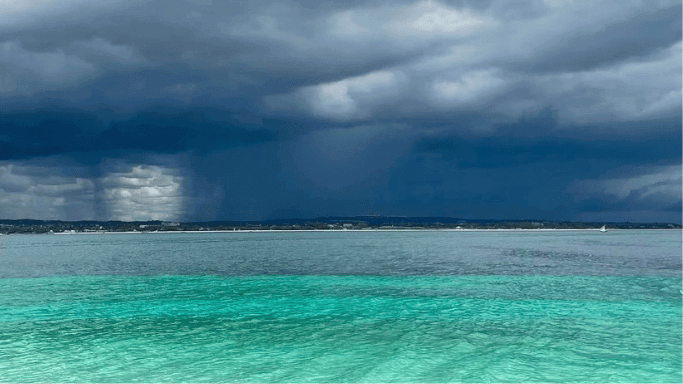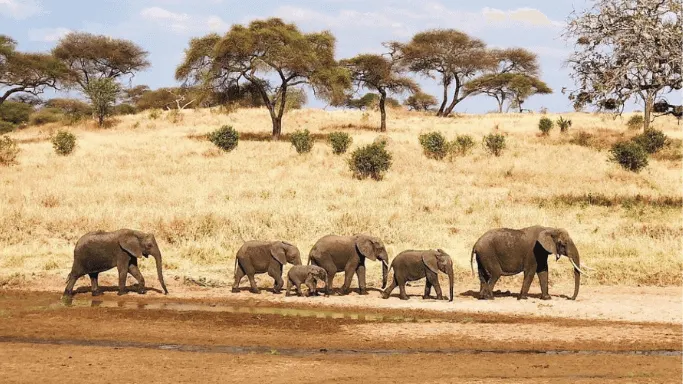Introduction
The Tanzania rainy season occurs in two main phases:
- The long rains, known locally as Masika.
- The short rains, called Vuli.
These two rainfall periods are shaped by seasonal monsoon winds and play a major role in the country’s weather and agricultural patterns. Masika typically brings prolonged, heavy rainfall across large parts of Tanzania, especially in the northern and coastal regions, turning the landscape lush and green. Vuli, on the other hand, brings shorter, less predictable showers, often in the late afternoon or at night, with more breaks of sunshine in between. Together, these seasons are essential for replenishing water sources, supporting food production, and keeping Tanzania’s ecosystems in balance.

The Tanzania rainy season also influences daily life and travel experiences. Farmers time their planting around the rains, and wildlife moves in response to the changing conditions, most famously during the Great Wildebeest Migration in the Serengeti. For travelers, these months can bring muddy roads, occasional delays, and seasonal lodge closures, especially in remote areas. However, they also offer greener scenery, fewer crowds, and excellent birdwatching. If you’re thinking of traveling during this period, it might help to explore the question: Is Visiting Tanzania During the Rainy Season Worth It? A better understanding of these unique seasons can help you make smarter travel choices and experience the country in a more authentic and peaceful way.
When is the Rainy Season in Tanzania?
The rainy season in Tanzania occurs twice a year: the short rains typically arrive from late October through December, while the long rains fall between late March and early June. These rains usually begin in the late afternoon and continue through the night, bringing cooler temperatures and fresh, green landscapes by morning. The timing and intensity of the rains can vary depending on the region, with the coastal and northern areas often receiving more rainfall. During these months, roads in remote areas may become muddy and difficult to access, and some safari lodges may temporarily close. However, the rains also help revive the natural environment, refill rivers and lakes, and prepare the soil for planting. For travelers, the Tanzania rainy season offers a chance to experience the country in a quieter, more vibrant setting, with fewer crowds and beautiful post-rain scenery.
How Predictable Is Rainfall During the Tanzania Rainy Season?
Rainfall during the Tanzania rainy season is generally seasonal but shows varying levels of predictability across the country. In western and southern zones such as the Lake region, Southern Highlands, and Western Highlands, rainfall tends to be more reliable and evenly spread, especially from December to April, due to higher consistency and lower variability. These areas have what’s known as unimodal rainfall patterns. In contrast, the eastern and northeastern parts of Tanzania, including coastal and island zones, experience more irregular rainfall with two distinct wet seasons October to December and March to May, making rainfall there less predictable. Studies show that about 80% of Tanzania’s rainfall predictability comes from seasonal patterns, while only 20% is due to the consistent timing of rain within each season. This means the rains are easier to expect by season, but harder to forecast day by day.
Overview of Tanzania’s Climate Zones
Tanzania’s rainy season patterns vary widely due to its four main climate zones: coastal, highland, semi-arid, and tropical savannah. Each zone experiences different rainfall timings, intensity, and duration, creating a complex weather landscape across the country.
- The coastal zone, including areas like Dar es Salaam, Zanzibar, and Pemba, experiences a humid tropical climate with consistent and often heavy rainfall during both the long rains (March to May) and short rains (October to December). Rainfall here is influenced by moisture-laden winds from the Indian Ocean.
- In the highland regions such as Mount Kilimanjaro, the Usambara Mountains, Mbeya, and Iringa, the rainy season tends to be longer and more intense, especially during the March to May period. These areas are cooler due to elevation, and rainfall often extends into June, creating a lush, misty environment.
- The semi-arid central zone, which includes areas like Dodoma and Singida, experiences low and unpredictable rainfall. The rainy season here is brief, generally falling between December and April, with frequent dry spells and significant year-to-year variability.
- In contrast, the tropical savannah zones of northern and southern Tanzania, including regions near the Serengeti and Ruaha National Park, follow a bimodal rainfall pattern. These areas receive the short rains around November to December and the long rains from March to May, but the reliability of these rains can differ from one year to the next.
This climatic diversity makes the Tanzania rainy season highly regional, with some zones experiencing regular, well-distributed rain and others facing high variability and timing shifts. Understanding these zones is crucial for anyone planning to visit during the rainy months, as conditions can range from light, overnight showers to heavy, sustained downpours depending on the region.
The Two Rainy Seasons in Tanzania.
Tanzania experiences two distinct rainy seasons each year: the long rains, known as Masika, and the short rains, known as Vuli. These seasonal shifts are driven primarily by the movement of the Intertropical Convergence Zone (ITCZ) and the arrival of Indian Ocean monsoon winds. The Masika season, from March to May, delivers sustained and heavier rainfall, especially in the northern and coastal regions. Vuli, on the other hand, occurs between November and December and brings shorter, scattered showers. Understanding the difference between these two rainy seasons is vital for anyone planning to visit Tanzania, as they directly affect road conditions, national park accessibility, and regional weather patterns.
i ) Long Rains in Tanzania (Masika): March to May

he long rains in Tanzania, called Masika, typically occur from March through May and are marked by consistent, heavy rainfall. This is considered the main rainy season, with April often being the wettest month of the year across much of the country. Masika brings dramatic transformations in the landscape plains turn bright green, rivers swell, and wetlands form across the lowlands. However, travel during this time can be challenging. In remote or rural areas, unpaved roads often become muddy and impassable. Some safari lodges and camps may close temporarily or offer reduced rates due to limited accessibility. Despite the disruptions, Masika creates exceptional opportunities for birdwatching and scenic photography, thanks to the rich vegetation and dramatic skies.
ii )Short Rains in Tanzania (Vuli): November to December
The short rains in Tanzania, known as Vuli, occur from early November through mid-December and tend to be brief but intense. Unlike the long rains, Vuli is often unpredictable showers usually fall in the afternoon or evening and are interspersed with long periods of sunshine. These rains are generally lighter but can still impact bush tracks and dirt roads, especially in national parks and rural areas. Despite some logistical interruptions, Vuli is still a viable time for travel, with most lodges open and wildlife viewing remaining excellent. The mix of light rains and clear skies creates vibrant, dust-free landscapes and comfortable temperatures, making it a good season for travelers who prefer fewer crowds and moderate weather.
Regional Breakdown of Rainfall
Rainfall intensity and duration vary across Tanzania’s regions, affecting travel plans significantly. Northern Tanzania, including Arusha, Serengeti, and Kilimanjaro, exhibits well-defined wet seasons due to a bimodal rainfall pattern driven by the movement of the Intertropical Convergence Zone (ITCZ). Coastal regions like Dar es Salaam and Zanzibar remain humid year-round but experience shorter, less intense rainfall episodes during both major rainy seasons. In contrast, southern and western parks such as Selous, Ruaha, Katavi, and Gombe are affected by the unimodal rainfall regime, receiving heavier and more prolonged rains. These regional differences are supported by climatological data spanning from 1981 to 2023, which highlight spatial and temporal variations in rainfall onset and duration.
i) Rainfall in Northern Tanzania

Northern Tanzania experiences a bimodal rainfall regime with two distinct wet seasons: the short rains (Vuli) from October to December and the long rains (Masika) from March to May. Research data shows that areas like Arusha, Serengeti, and Kilimanjaro often receive substantial rainfall during Masika. For instance, April is typically the wettest month, with regions like Serengeti receiving around 200mm of rain. This rainfall is crucial for ecological transformations, especially the greening of the plains, which enhances photographic safari opportunities. However, consistent rain can make some roads impassable, especially towards the end of April, aligning with findings from CHIRPS data showing increased rain probabilities (rr) in these areas after an initial wet day.
ii) Rainfall in Southern Tanzania
Southern regions such as Selous Game Reserve, Ruaha National Park, and Ruvuma follow a unimodal rainfall pattern from November to April. These regions tend to experience higher rainfall volumes, particularly between December and April. Studies show that places like Ruvuma have peak probabilities of continued rainfall (rr) in February and March, reaching up to 0.77. This makes the southern parks prone to flooding, poor road conditions, and limited accessibility. As a result, many safari lodges in these areas close during peak rainfall months. However, the wet conditions also contribute to thriving biodiversity and vibrant vegetation, offering a unique, albeit challenging, safari experience.
iii) Rainfall in Coastal Areas ,Tanzania

Coastal regions, including Dar es Salaam, Tanga, and the Zanzibar Archipelago (Unguja and Pemba), are significantly influenced by the Indian Ocean monsoon system. These areas receive bimodal rainfall, with short rains (OND) and long rains (MAM), but the intensity and duration are usually more moderate compared to inland regions. For example, Dar es Salaam shows a statistically significant trend towards earlier rainfall onset, with a downward slope of -0.098 days per year. Rain events here are typically short-lived and followed by clear skies, making beach activities and travel still feasible. Zanzibar, while experiencing both rainy seasons, tends to have shorter and more predictable showers, maintaining its appeal as a year-round destination.
iv) Rainfall in Western Tanzania
Western regions such as Katavi, Kigoma, and Gombe are characterized by high rainfall during the long rainy season. From March to May, these areas see increased probabilities of continuous rainfall, particularly after rainy days (high rr values). For instance, Kigoma’s rainfall probabilities peak in December and remain high through February and March, with rr values reaching up to 0.63. This pattern, confirmed by Mann-Kendall trend analyses, indicates a consistent risk of road inaccessibility due to waterlogging. Despite the logistical challenges, the low visitor numbers during this period provide a rare opportunity for solitude and an immersive wilderness experience in parks that are otherwise difficult to access.

Monthly Weather Guide During the Rainy Season in Tanzania
i) March
March marks the beginning of the long rains (Masika), especially in southern, coastal, and some northern areas. Rainfall onset begins around early March in regions like Geita, Mwanza, and Dar es Salaam, with rain probabilities climbing steadily through the month. Expect humid days with scattered thunderstorms, lush landscapes, and warmer temperatures averaging 26°C–30°C. While still travelable, muddy tracks begin to form in remote areas.
ii) April
April is the peak of Tanzania’s wet season, particularly in the Lake Zone, Serengeti, and coastal regions. Rainfall can exceed 200mm, and consecutive rain days (rr) reach over 70% in areas like Mara and Kagera. Many safari camps and lodges in remote parks temporarily shut due to impassable roads. However, the scenery is spectacular vibrant green plains, active birdlife, and fewer tourists make it a photographer’s dream.
iii) May
Rainfall begins to gradually subside, particularly in central and northern Tanzania, although some southern and western regions still experience moderate rain. With clearer skies returning and the shoulder season in full effect, May offers great value and increasing accessibility to parks. Wildlife is active, and conditions begin improving for road travel, though trails may still be slippery in some areas.
iv) June
In the highland regions including Mount Kilimanjaro, the Usambara Mountains, Mbeya, and Iringa the rainy season extends into June, unlike most other areas. The combination of elevation and persistent moisture creates cooler temperatures and a misty, emerald-green landscape. These areas remain lush and fog-kissed, offering a unique contrast to the drier lowlands. While much of Tanzania begins its dry season, trekking and nature walks in the highlands are scenic but can still be damp.
v) November & December
The short rains (Vuli) return, especially in northern and coastal Tanzania. These rains are lighter, more localized, and often confined to afternoon showers followed by sun. Rainfall rarely exceeds 100mm, and the chance of daily rain stays under 22% in most regions. This is a great time for photography, as fresh greenery and dramatic skies enhance the landscape without significantly impacting travel plans.
What is the temperature like in Tanzania during the rainy season?
During the Tanzania rainy season, temperatures typically range from 20°C to 30°C (68°F to 86°F), depending on region and altitude. Coastal cities like Dar es Salaam and Zanzibar remain hot and humid, while higher areas such as Arusha, Mbeya, and Iringa are cooler, especially after sunset. In the southern and southwestern highlands, temperatures can fall to around 10°C (50°F) at night. Mountain regions like the Usambara and Uluguru also stay relatively cool throughout the rainy months.
Tanzania is generally a warm country, and extreme cold is uncommon except in very high-altitude locations. At the summit of Mount Kilimanjaro, for example, temperatures during the rainy season can drop as low as –20°C (–4°F), far below the freezing point. However, in most areas, the weather remains mild and comfortable, with short, refreshing rain showers followed by breaks of sunshine.
Best Things to Do During the Rainy Season in Tanzania
April marks the peak of Tanzania’s long rainy season (Masika), a time often misunderstood by travelers. While it does bring near daily rainfall primarily in the form of afternoon thunderstorms that quickly dissipate it also brings lush landscapes, vibrant wildlife activity, and the lowest tourist crowds of the year. For those willing to embrace the elements, the rainy season can reveal a more intimate, affordable, and awe-inspiring side of Tanzania.
1) The northern Tanzania
in northern Tanzania, the Serengeti remains a top destination during April. Despite muddy roads, the central Seronera region teems with wildebeest, zebras, and predators, as the Great Migration continues across the green plains. The rains nourish the grasses, offering rich feeding grounds and dramatic backdrops for wildlife photography.

The Ngorongoro Crater thrives during this time. With over 25,000 animals packed into its basin including elephants, lions, and black rhinos the crater is arguably even more magical during the rains, as mists swirl across its rim and the crater floor bursts with life.

The nearby Lake Manyara National Park also shines during the wet season. Two-thirds of the park is flooded, turning it into a haven for flamingos, storks, and hippos. The verdant conditions make canoe safaris possible, and with fewer vehicles, sightings of tree-climbing lions and baboons become more serene and uninterrupted.
For mountaineers and hikers, April brings challenges and rewards. Mount Kilimanjaro becomes a remote and misty giant, only for the well-prepared. Trails are slippery, and the peak is often snow-covered, offering stunning alpine scenes with virtually no crowds. Similarly, trekking in the Usambara Mountains or ascending Mount Hanang(Tanzania’s third highest peak) offers misty forests, cascading waterfalls, and a tangible sense of adventure far from the usual trekking season bustle.
Cultural destinations such as Mwanza, Tanzania’s lakeside city, remain active and rewarding during the rains. With its backdrop of Lake Victoria and attractions like the Sukuma Museum, visitors can explore the country’s largest ethnic group’s history in peaceful, green surroundings. Nearby Lake Natron, despite some access limitations, draws bird lovers with its massive flamingo colonies, while the dramatic scenery adds to the mystique of the location.
And finally, for those intrigued by prehistory, the legendary Olduvai Gorge where 1.8-million-year-old hominin fossils were discovered remains a compelling stop regardless of the weather. Its dusty trails and rocky escarpments feel even more timeless under cloudy skies and echo with the stories of early humans.
2) The Southern Circuit
Further south, while the Southern Circuit including Ruaha and Nyerere (Selous) National Parks is less accessible due to heavy rainfall, the reward is solitude. April is the quietest month for tourism here. These regions see a resurgence of life, with migratory birds returning and herds moving across flooded savannahs. The occasional difficulty navigating wet tracks is offset by the sense of exclusivity and raw connection to nature. Ruaha, in particular, is known for hosting spectacular bird migrations during this season.
3) The coastline and islands.
Along the coastline and islands, April is one of Tanzania’s most underrated travel months. In Zanzibar, Mafia, and Pemba Islands, rains typically come in short, dramatic bursts often in the afternoon followed by extended hours of sunshine. With most tourists avoiding the season, travelers benefit from uncrowded beaches, deep discounts on beachfront lodges, and clearer views for photography.

This is also the best time for snorkeling in Mafia Island, as coral reefs come alive under freshly washed waters, and exploring UNESCO-listed Stone Town without the usual crowds. On Pemba, often called the “Green Island,” the lush vegetation thrives, offering a vibrant tropical setting. Further down the coast, Kilwa Kisiwani and Songo Mnara, two UNESCO World Heritage Sites, become even more atmospheric in the rain misty ruins, quiet coastal trails, and the echo of Swahili history make them ideal for cultural explorers who appreciate solitude and authenticity.
4) Western Tanzania

Even in remote Western Tanzania, In Kigoma destinations like Mahale Mountains National Park and Gombe Stream offer incredible opportunities during the rains. In Mahale, April brings roaring waterfalls, and the dense forest becomes even more alive. With few tourists, the chance to observe chimpanzees in their natural habitat becomes deeply personal and unforgettable. Gombe, similarly, offers an unmatched sense of solitude visiting in April may mean having the park all to yourself.
April in Tanzania is not about enduring the rain, it’s about embracing a wilder, greener, and more personal journeythrough one of Africa’s most diverse and naturally stunning countries.
What to Pack for the Rainy Season in Tanzania
Packing wisely for the rainy season in Tanzania (typically March–May and November–December) can make the difference between a challenging trip and an unforgettable one. Unlike endless downpours, Tanzania’s rains often arrive as intense afternoon showers, especially in areas like the Serengeti, Usambara Mountains, and Zanzibar. These rains are unpredictable, so every traveler should prepare for both sudden wet spells and humid sunshine sometimes within the same hour.
1) Lightweight, breathable, quick-dry clothing.
Materials like nylon or polyester dry faster than cotton and help regulate body temperature in the humid tropics. Long-sleeved shirts and convertible pants are excellent choices: they protect against mosquitoes, UV rays, and can easily be layered during chilly evenings in highland zones like Kilimanjaro, Mbeya, or Iringa, where rainfall can extend into June and create misty, cool conditions.
2) Waterproof jacket
A reliable, full-coverage waterproof jacket with a hood is essential. Opt for one with ventilation zippers, so you stay dry without overheating during nature walks or game drives. For added protection, bring a lightweight rain poncho that can cover your daypack—critical when you’re in remote areas with no shelter, such as Ruaha National Park or Lake Natron.
3) Waterproof hiking boots
When it comes to footwear, waterproof hiking boots with non-slip soles are non-negotiable. Dirt roads and bush tracks in parks like Katavi or Selous can become muddy and treacherous, and solid footwear keeps your footing secure. Complement this with water-resistant gaiters to prevent mud and water from seeping in during hikes or game walks. Flip-flops or sandals also come in handy for lodge showers or casual evenings.
4) Dry bags or sealable waterproof pouches
Electronics and valuables should be stored in dry bags or sealable waterproof pouches. This is especially important for photographers and safari-goers, since spontaneous downpours can ruin equipment in seconds. A waterproof backpack cover or a daypack with built-in rain protection is a smart investment for daily excursions.
5) Insect Repellant
Insect protection is crucial during the wet season. Standing water increases mosquito populations, especially in lowland and coastal regions like Dar es Salaam, Zanzibar, and the Lake Victoria basin. Pack a high-percentage DEET or Picaridin-based insect repellent, and sleep under permethrin-treated mosquito nets if you’re staying in rural or forested areas. Additionally, long-sleeved nightwear, ankle socks, and loose clothing can serve as physical barriers against bites. Consult a travel clinic for antimalarial prophylaxis before departure.
Also consider packing:
- Microfiber towel: fast-drying and compact, useful in humid climates.
- Headlamp or flashlight: power cuts can happen, especially during storms.
- Reusable water bottle with filter: stay hydrated and minimize plastic waste.
- Packable hat with a brim: offers shade and rain protection simultaneously.
- Quick-dry laundry kit: includes travel detergent and a portable clothesline—useful when you’re stuck indoors due to rain.
- Ziplock bags: for storing damp clothes or muddy gear temporarily.
- Thermal base layer: surprisingly helpful in cooler highland areas like Mount Hanang.
Lastly, remember that April is low tourism season, meaning you’ll often have entire lodges, parks, or beaches to yourself. With the right gear, the rainy season becomes not an obstacle, but an opportunity to experience Tanzania’s lush green transformation, dramatic skies, wildlife abundance, and cultural richness, all without the crowds.
Final Travel Tips for Tanzania’s Rainy Season
Book flexible accommodations, monitor local weather reports, and prepare for spontaneous adventure during the Tanzania rainy season. Partnering with local guides ensures access to the most up-to-date trail and wildlife conditions. If you pack smart and stay open-minded, your rainy season adventure could be the most rewarding of all.




